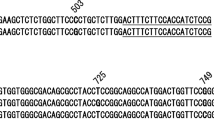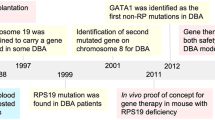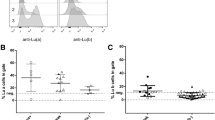Abstract
Fanconi anaemia is an autosomal recessive disease for which four known complementation groups exist. Recently, the gene defective in complementation group C (FACC) has been cloned. In order to determine the fraction of Fanconi anaemia caused by FACC mutations, we used reverse transcription PCR and chemical mismatch cleavage (CMC) to examine the FACC cDNA in 17 FA cell lines. 4/17 patients (23.5%) had mutations in this gene. Two Ashkenazi–Jewish individuals were homozygous for an identical splice mutation. Three additional Jewish patients bearing this allele were found upon screening 21 other families. We conclude that a common mutation in FACC accounts for the majority of Fanconi anaemia in Ashkenazi–Jewish families.
This is a preview of subscription content, access via your institution
Access options
Subscribe to this journal
Receive 12 print issues and online access
$209.00 per year
only $17.42 per issue
Buy this article
- Purchase on Springer Link
- Instant access to full article PDF
Prices may be subject to local taxes which are calculated during checkout
Similar content being viewed by others
References
Fanconi, G. Familial constitutional panmyelocytopathy, Fanconi's anemia (F.A.) I. Clinical aspects. Semin. Hematol. 4, 233–240 (1967).
Billardon, B. & Moustacchi, E. Comparison of the sensitivity of Fanconi's anemia and normal fibroblasts of sister-chromatic exchanges by photoaddition of mono- and bi-functional psoralens. Mutat. Res. 174, 241–246 (1986).
Auerbach, A.D. et al. Clastogen-induced chromosomal breakage as a marker for first trimester prenatal diagnosis of Fanconi anemia. Hum. Genet. 73, 86–8 (1986).
Strathdee, C.A., Duncan, A.M.V. & Buchwald, M. Evidence for at least four Fanconi anaemia genes including FACC on chromosome 9. Nature Genet. 1, 196–198 (1992).
Mann, W.R. et al. Fanconi anemia: evidence for linkage heterogeneity on chromosome 20q. Genomics 9, 329–337 (1991).
Strathdee, C.A., Gavish, H., Shannon, W.R. & Buchwald, M. Cloning of cDNAs for Fanconi's anemia by functional complementation. Nature 356, 763–767 (1992).
Cotton, R.G., Rodrigues, N.R. & Campbell, R.D. Reactivity of cytosine and thymine in single-base-pair mismatches with hydroxylamine and osmium tetroxide and its application to the study of mutations. Proc. natn. Acad. Sci. U.S.A. 85, 4397–401 (1988).
Cotton, R.G.H. Detection of single base changes in nucleic acid. Adv. genome Biol. 1, 253–300 (1992).
Gibson, R.A., Buchwald, M., Roberts, R.G. & Mathew, C.G. Characterization of the exon structure of the fanconi anemia group C gene by vectorette PCR. Hum. Molec. Genet. (in the press).
Shapiro, M.B. & Senapathy, P. RNA splice junctions of different classes of eukaryotes: sequence statistics and functional implications in gene expression. Nucl. Acids Res. 15, 7155–74 (1987).
Senapathy, P., Shapiro, M.B. & Harris, N.L. Splice junctions, branch point sites, and exons: sequence statistics, identification, and applications to genome project. Meth. Enzymol. 183, 252–78 (1990).
Wu, D.Y., Nozari, G., Schold, M., Conner, B.J. & Wallace, R.B. Direct analysis of single nucleotide variation in human DNA and RNA using in situ dot hybridization. DNA 8, 135–42 (1989).
Gravel, R.A., Triggs, R.B.L. & Mahuran, D.J. Biochemistry and genetics of Tay-Sachs disease. Can. J. neurol. Sci. (1991).
Beutler, E., Gelbart, T., Kuhl, W., Zimran, A. & West, C. Mutations in Jewish patients with Gaucher disease. Blood 79, 1662–6 (1992).
Mononen, I. et al. Aspartylglycosaminuria in a non-Finnish patient caused by a donor splice mutation in the glycoasparaginase gene. J. biol. Chem. 267, 3196–3199 (1992).
Hodges, P.E. & Rosenberg, L.E. The spfash mouse: a missense mutation in the ornithine transcarbamylase gene also causes aberrant mRNA splicing. Proc. natn. Acad. Sci. U.S.A. 86, 4142–6 (1989).
Nienhuis, A.W. et al. Gene therapy approaches for enzyme deficiencies p. 34 (National Heart, Lung and Blood Institute, Bethesda, Maryland, 1992).
Auerbach, A.D., Verlander, P.C., Mann, W.R., Allen, R.G. & Adler-Brecher, B. Linkage of a Fanconi anemia gene to chromosome 20q. p. 18 (National Heart, Lung and Blood Institute, Bethesda, Maryland, 1992).
Buchwald, M. et al. Cloning of the Fanconi anemia C gene by functional complemenation 1–19 (National Heart, Lung and Blood Institute, Bethesda, Maryland, 1992).
Boyd, J.B., Harris, P.V. & Leonhardt, E.A. Genetic and molecular analysis of the Drosophila mus308 gene, a potential analogue of Fanconi anemia A. p. 15 (National Heart, Lung and Blood Institute, Bethesda, Maryland, 1992).
Moses, R.E. & Beaudet, A.L. Apurinic DNA endonuclease activities in repair-deficient human cell lines. Nucl. Acids Res. 5, 463–73 (1978).
Sun, Y. & Moses, R.E. Reactivation of psoralen-reacted plasmid DNA in Fanconi anemia, xeroderma pigmentosum, and normal human fibroblast cells. Somatec. Cell molec. Genet. 17, 229–38 (1991).
Kobayashi, K., Jackson, M.J., Tick, D.B., OBrien, W.E. & Beaudet, A.L. Heterogeneity of mutations in argininosuccinate synthetase causing human citrullinemia. J. biol. Chem. 265, 11361–7 (1990).
Chomczynski, P. & Sacchi, N. Single-step method of RNA isolation by acid guanidinium thiocyanate-phenol-chloroform extraction. Anal. Biochem. 162, 156–9 (1987).
Mullis, K.B. & Faloona, F.A. Specific synthesis of DNA in vitro via a polymerase-catalyzed chain reaction. Methods Enzymol. 155, 335–50 (1987).
Kogan, S.C., Doherty, M. & Gitschier, J. An improved method for prenatal diagnosis of genetic diseases by analysis of amplified DNA sequences: application to hemophilia A. New Engl. J. Med. 317, 985–990 (1987).
Grompe, M., Muzny, D.M. & Caskey, C.T. Scanning detection of mutations in human ornithine transcarbamoylase by chemical mismatch cleavage. Proc. natn. Acad. Sci. U.S.A. 86, 5888–92 (1989).
Sambrook, J., Fritsch, E.F. & Maniatis, T. Molecular Cloning: A Laboratory Manual (Cold Spring Harbor Laboratory Press, Cold Spring Harbor, 1989).
Sanger, F., Nicklen, S. & Coulson, A.R. DNA sequencing with chain-terminating inhibitors. Proc. natn. Acad. Sci. U.S.A. 74, 5463–5467 (1977).
Cohen, M.M. et al. Ataxia teleangiectasia: chromosomal stability in continous lymphoblastoid cell lines. Cytogenet. Cell Genet. 23, 44–52 (1979).
Author information
Authors and Affiliations
Rights and permissions
About this article
Cite this article
Whitney, M., Saito, H., Jakobs, P. et al. A common mutation in the FACC gene causes Fanconi anaemia in Ashkenazi Jews. Nat Genet 4, 202–205 (1993). https://doi.org/10.1038/ng0693-202
Received:
Accepted:
Issue Date:
DOI: https://doi.org/10.1038/ng0693-202
This article is cited by
-
Fanconi anemia: current insights regarding epidemiology, cancer, and DNA repair
Human Genetics (2022)
-
Genetic Counseling for Fanconi Anemia: Crosslinking Disciplines
Journal of Genetic Counseling (2014)
-
Inherited bone marrow failure syndromes in 2012
International Journal of Hematology (2013)
-
Association of FANCC polymorphisms with FEV1 decline in aspirin exacerbated respiratory disease
Molecular Biology Reports (2012)
-
Analysis of FANCB and FANCN/PALB2 Fanconi Anemia genes in BRCA1/2-negative Spanish breast cancer families
Breast Cancer Research and Treatment (2009)



